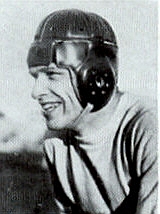Los Angeles Wildcats (AFL)
| Founded | 1926 |
|---|---|
| Folded | 1926 |
| Based in | Chicago, Illinois, United States |
| League | American Football League (1926) |
| Team history | Los Angeles Wildcats (1926) |
| Team colors | Light Brown, White |
| Head coaches | Jim Clark |
| Owner(s) | C. C. Pyle Red Grange George "Wildcat" Wilson |
| Named for | George “Wildcat” Wilson |
| Home field(s) | Traveling Team |
The Los Angeles Wildcats (also reported in various media as Pacific Coast Wildcats, Los Angeles Wilson Wildcats and Wilson's Wildcats) was a
Origin

The existence of the Wildcats began with the 1926 formation of the American Football League by C. C. Pyle, a sports agent who represented star back Red Grange. Pyle's application for a National Football League franchise in New York was rejected because Tim Mara, owner of the New York Giants, objected to Pyle's proposed intrusion into the Giants’ territory. Armed with a five-year lease at Yankee Stadium, Pyle subsequently announced the formation of the American Football League as a showcase for his client.
The league was also a showcase for another Pyle client who was an
The team was owned by
American Football League
As the team began league play, it became evident that Wilson was not the only weapon that the Wildcats had. Coach Jim Clark had the versatile
Originally scheduled to play only 10 games, the Wildcats played additional contests as last-minute “fill-in” opponents as one team after another in the American Football League folded or otherwise left the league. Immediately after tying the
By the end of October, the
Only two official AFL games were left to play in December 1926. On the 5th, the Wildcats shut out the Bulls 5–0 on a frozen field in Comiskey Park, while the Bulls hosted the Yankees the following Sunday as the visiting team wrapped up the 1926 season of the American Football League with a 7–3 victory. At the same time, in a snowstorm at the Polo Grounds, the league champion Quakers were crushed, 31–0, by the New York Giants in a game that marked the end of the American Football League, December 12, 1926.
| Year | W | L | T | Finish | Coach |
|---|---|---|---|---|---|
| 1926 | 6 | 6 | 2 | 4th | Jim Clark |
After the first AFL
Two days after the end of the 1926 season (and of the AFL), the Wildcats and the New York Yankees started a series of exhibition games as the two Pyle-owned teams went on a
With the dissolution of the American Football League (Pyle's Yankees were preparing to join the NFL under an arrangement with New York Giants owner Tim Mara, who acquired the assets of the defunct
- Mal Bross – Green Bay Packers
- Ted Bucklin – Chicago Cardinals
- Walden Erickson – Pottsville Maroons
- Ray Flaherty – New York Yankees
- Ted Illman – Chicago Cardinals
- Jim Lawson – New York Yankees
- Ray Stephens – New York Yankees
- John Vesser – Chicago Cardinals
Flaherty continued to play until 1935 (taking 1930 off to teach college football), then became head coach of the
References
- ^ a b 1926 American Football League from Elias Sports Bureau and Pro Football Research Association Linescore Committee Archived June 5, 2015, at the Wayback Machine
- ^ a b c Schedules and scores of the teams in the 1926 American Football League Archived July 13, 2009, at the Wayback Machine – “Ghosts of the Gridiron”
- ISBN 0-312-11435-4
